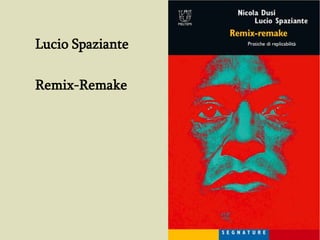
Remix Remake
- 2. Sociosemiotics and replica practices • Contemporary forms of media textuality are typical expressions both of globalization encounters and media crossings. • Thus they lead us to reflect on producing and consuming texts, and on the use of contemporary semiotic analytical tools.
- 3. Modularity and matrix • Our focus will be on multimedia and audiovisual medial forms • built on repeated and varied modularities, • and on matrix owed to other media, such as TV formats and other cases of seriality.
- 4. Hybrids • Today, a key role in cultural production seems to be played by “replica practices”, considered as source of many trans-textual hybrids • Those hybrids not to be treated only by means of categories of genre or as a simple tokens of ‘post-modern artifacts’.
- 5. What are replica practices? • shared procedures of invention, • originated both from memories and textual archives, • which embody consolidated practices of production and enjoyment inside texts themselves
- 6. Texts and practices • Texts are fixed products, “attested” texts : • Practices are texts in action, processes, interactions • Practices of reading something • Practices of use
- 7. Texts and practices •Practices are able to reopen old texts, generating other new texts • On the opposite we find texts able to generate practices •Let’s think of something like matrice texts able to produce new versions, new connections
- 8. Texts and cultures memories • Texts are allowed to keep previous uses in their memories • Texts are also able to act on memories • Mythopoiesis: remixes and remakes are devices of generating classics.
- 9. Director’s cut & new editions • Cultural industry shows a tendency to create and “discover”new classic texts, enriched with extras or outtakes, as new masterworks. • From postumous cases like Touch of Evil director’s cut by Orson Welles (USA 1958-1999) until anniversary edition as 25th of The Clash London Calling.
- 10. Target - Source • In replica forms we stand beside target texts that give values to source texts from which they come.
- 11. We can observe two complementary macro- tendencies: - continuity with past - tendency to differentiation Example- Psycho: Hitchcock & Van Sant Identity or difference?
- 12. Toward Cultural Semiotics • Widespread intertextuality : “each text become a potential intertext in itself ” Example : The Matrix • Intermediality: fragments and characters circulating across different media (literature, tv, film, games)
- 13. Replica as a Praxis •The Matrix is not a sequel but a whole text which will be after divided •composed of heterogeneous juxstapositions •(kung-fu sets, western genre narrative structures, cyberpunk imagination, videogame rhythm, working on a modular standard of composition, playing on different media platforms, useful in the creation of clones.
- 14. From Cinema to Pop Music • Starting from the field of cinema the perspective can be broadened to the whole audiovisual sphere. • For example cases of reinterpretation as cover and remix (intended as intertextual productive practices coming from contemporary popular culture).
- 15. Pop music • We find version of texts (re-playing, re-recording, reduction, adaptation, exc.) realized by the same author • Or, a reinterpretation (the so-called cover) where you have a new player that creates a new version (with different degrees of fidelity to original) • Or, a remix, as to say a new intervention on original material itself with reelaboration, also adding interpolations.
- 16. Version
- 17. Cover
- 18. Remix
- 19. Reference: N. Dusi, L. Spaziante, Remix-Remake: pratiche di replicabilità, Roma, Meltemi, 2006.